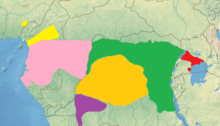Gray cheek indication
| Gray cheek indication | ||||||||||||
|---|---|---|---|---|---|---|---|---|---|---|---|---|

Gray cheek indication ( Lophocebus albigena ) |
||||||||||||
| Systematics | ||||||||||||
|
||||||||||||
| Scientific name | ||||||||||||
| Lophocebus albigena | ||||||||||||
| ( Gray , 1850) |
The gray-cheeked specimen ( Lophocebus albigena ) is a primate species from the family of vervet monkeys (Cercopithecidae). They are often referred to as the Osman Hill Mangabe , the Johnston Mangabe and the Uganda Mangabe together as a mantle .
features
Gray cheek indications are relatively slender primates with long limbs and a long tail. They reach a head body length of 40 to 72 centimeters, the tail is 55 to 100 centimeters long. The weight is 4 to 11 kilograms, with the males being slightly heavier than the females. The fur is predominantly black or black-brown in color, with the exception of the long, white-gray cheek hairs and the long, gray hair on the shoulders, to which they owe their name to coat.
distribution and habitat

pink - gray cheek mange
red - Uganda mangabe
yellow - Osman Hill mangabe
green - Johnston mangabe
orange - Schopfmabe
purple - Opdenbosch mangabe
Gray cheek indications are native to central Africa . Excluding the separated species mentioned in the introduction, their range includes southwestern Cameroon (south of the Sanaga River), Equatorial Guinea , Gabon and the Republic of the Congo . Their habitat is forests, primarily tropical rainforests .
Way of life
These animals are diurnal tree dwellers that rarely come to the ground. They live together in groups of 10 to 20 animals. These consist of one or more males, numerous females and their offspring. While foraging for food, the groups sometimes split into smaller subgroups. They are territorial animals that use screams to communicate their whereabouts to other groups. The males have pronounced throat pouches for this purpose. As a result of this understanding, there are seldom aggressive encounters between different groups.
Gray cheek indications are omnivores , but they mainly eat fruits, nuts and seeds. Flowers, leaves as well as insects and other small animals complement the menu.
Reproduction
Mating can take place all year round. After a gestation period of around 175 days, the female usually gives birth to a single young. Sexual maturity occurs in females at three years of age, in males at five to seven years. While males have to leave their birth group at this point in time, females remain in the same group throughout their lives.
Systematics
The gray-cheeked indications are classified in the genus of the black indications ( Lophocebus ), which, according to recent research, is not particularly closely related to the white-eyed mangabies ( Cercocebus ). The Schopfmote , which lives south of the Congo River , is mostly recognized today as a separate species.
In 2007, Colin Groves divided the coat indication into four types, which differ in the color of the long shoulder hair , among other things: the gray cheek indication is gray, the Osman Hill Mangabe ( L. osmani ) reddish-brown and the Johnston Mangabe ( L. johnstoni ) dark brown. The Uganda mangabey ( L. ugandae ) finally is generally small and has a shorter skull. The first three populations mentioned had been recognized as subspecies for a long time, and Groves raised them to species status.
threat
Gray-cheeked indications are hunted for their meat in some places and suffer from the destruction of their habitat, sometimes they are also persecuted when they devastate plantations. The IUCN , which summarizes the above-mentioned species with the gray-cheeked indication, sees the species as widespread and lists it as "not endangered" ( least concern ).
literature
- Ronald M. Nowak: Walker's Mammals of the World. Johns Hopkins University Press, Baltimore 1999, ISBN 0-8018-5789-9 .
- Thomas Geissmann : Comparative Primatology. Springer, Berlin et al. 2003, ISBN 3-540-43645-6 .
- Colin Groves : The Endemic Uganda Mangabey (Lophocebus ugandae), and Other Members of the albigena-Group (Lophocebus). In: Primate Conservation. No. 22, 2007, pp. 123-128, doi : 10.1896 / 052.022.0112 .
Web links
- Lophocebus albigena in the endangered Red List species the IUCN 2009 Posted by: J. F. Oates, C. P.Groves, C. Ehardt, 2008. Accessed on 5 November of 2009.
- Information at Animal Diversity Web (English)